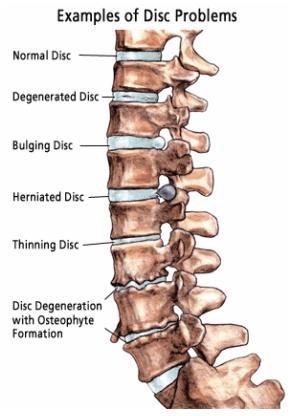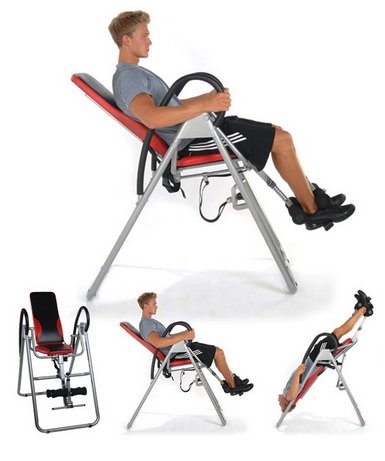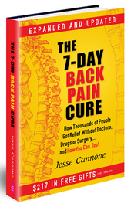|
Inversion Table Information
Inversion table information - this page introduces the concept of inversion therapy and links to several pages of information about inversion tables, inversion therapy and its benefits and use.
Inversion Table Information - Your Back
First, let's look at the issue of spinal compression, the problems it causes and what can be done about it. From the moment we are born, our bodies are subject to the pull gravity, a force that continuously creates pressure and stress on all of our muscles, bones, joints and ligaments.
By far, the part of the body that is affected most by gravity is the spine as it bears the weight of the upper body and whatever we are carrying. Also, because it is built of so many parts (designed to give us flexibility and ease of movement - can you image life with the bones from your skull to your pelvis all fused together?) those parts are subject to the stress of being pushed against each other. As gravity compresses the discs and vertebrae against each other,
muscle imbalance,
poor posture and other problems result in uneven forces within the spine and we start having
low back pain
and other problems.
 The inside of the discs consists of jelly-like material that acts like a shock absorber, providing flexibility and cushioning when you are sitting, standing or exercising. During normal daily activities, gravity causes fluid to squeeze out of your discs into the adjacent soft tissue. As this happens over the course of the day, the space between the discs decreases and you actually lose height. Some people may lose as much as ¾ inch in a day!
When you're asleep and horizontal, some - but not always all - of the fluid soaks back into the discs. Because of successive, only-partial recoveries at night, the average person loses ½ inch to 2 inches in height by their senior years and some much more.
Spinal compression can result in there being insufficient distance between the vertebrae which can cause pressure on the nerve roots resulting in pain. And if pressure on the discs is distributed unevenly due to muscle imbalances or carrying uneven loads they may start to bulge or herniate, causing spinal damage and, likely, chronic pain. These problems are largely the result of gravity, although we are often at fault for carrying too much - sometimes of our own weight - or moving or carrying loads improperly.
However, it turns out that while gravity plays a major role in these problems it can be used to advantage to help alleviate them as well. This can be achieved by assuming an inverted (head-down) or partially inverted (at somewhat of a downward angle) posture - lying on a slanted surface, head down. This, of course, relieves the effect of gravity on our spine and can even pull in the other direction to help our back recover from spinal compression.
Inversion Table Information - History and Scientific Studies
Inversion therapy has been used since 3,000 B.C. to re-balance the body, help increase circulation, stimulate the brain, enhance glandular system functioning, and relieve pressure on the abdominal organs. Hippocrates, the "Father of Medicine," devised his own inversion therapy and crude inversion "table" by hoisting his patients on a ladder with a series of ropes and pulleys to harness gravity in an effort to stretch his patients and relieve their ailments - don't try this.
A study conducted in 1978 testing EMG activity (indicating the amount of muscle pain in participants) showed a 35% decrease in pain - in as little as 10 seconds after becoming inverted. This proves you can experience near-instant relief... as well as the long-term health benefits. One study involved 175 patients who had been experiencing back pain badly enough that they were unable to work. After just eight inversion treatments - 88.6% of them had enough pain reduction that they were able to return to their jobs full-time.
Another study found that inversion sessions just 1-2 times per day on average resulted in a 33% decrease in sick days due to pain back... plus a noticeable drop in pain throughout the entire year. Virtually every study ever done has shown a noticeable decrease in pain for the people using inversion therapy.
A study conducted by the head of Neuroscience at Newcastle University showed that inversion therapy reduced the probability of needing back surgery by 70.5%!
Inversion Table Information - Yes, You Can Do It
A very major factor in back problems is spinal compression - which can only be addressed through inversion therapy. But how do you do inversion at home? You could rig up the ironing board against some furniture and try not to slide off but that obviously has limitations and perhaps risks - and you're certainly not going to go right upside down doing that - please, don't try. The first thing is to learn about inversion therapy, what it can do and whether it is right for you.
Here are links to several pages of inversion table information. On these pages, you about can find all you need to know inversion therapy:
- What Is An Inversion Table?
- Benefits of an Inversion Table
- Inversion Table for Back Pain - Page coming soon
- Dangers of Inversion Tables
- Inversion Table Benefits
- More Benefits of an Inversion Table
- Inversion Table for a Herniated Disc - Page coming soon
- Inversion Table for Sciatica - Page coming soon
Product pages:
Learn more about how you can enjoy your own inversion table.
|
Keep up to date with
valuable insights into
pain management via
a healthy lifestyle.
Receive the monthly
Natural Pain Relief
Guide Newsletter.
News articles, health
tips, specials, freebies.
Enter your email and name
in the form to the right.
|
|
|










New! Comments
Have your say about what you just read! Leave me a comment in the box below.